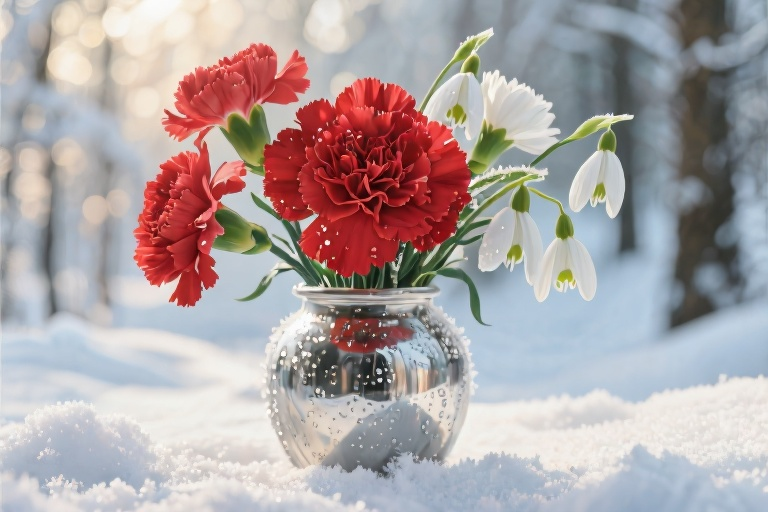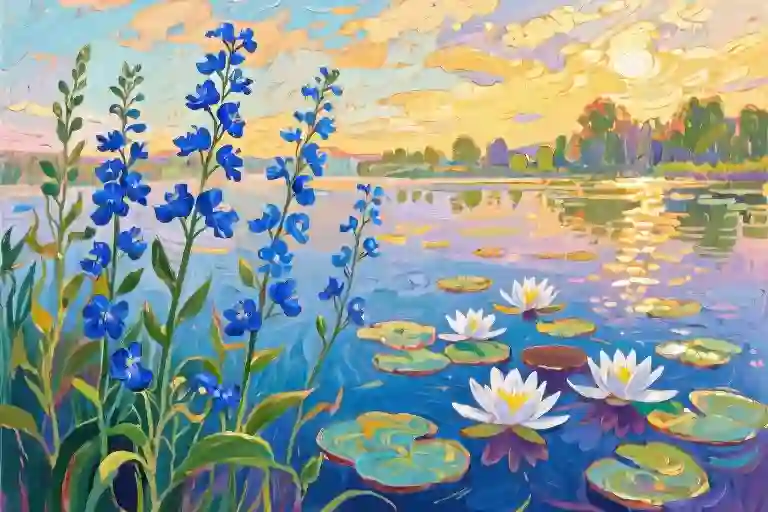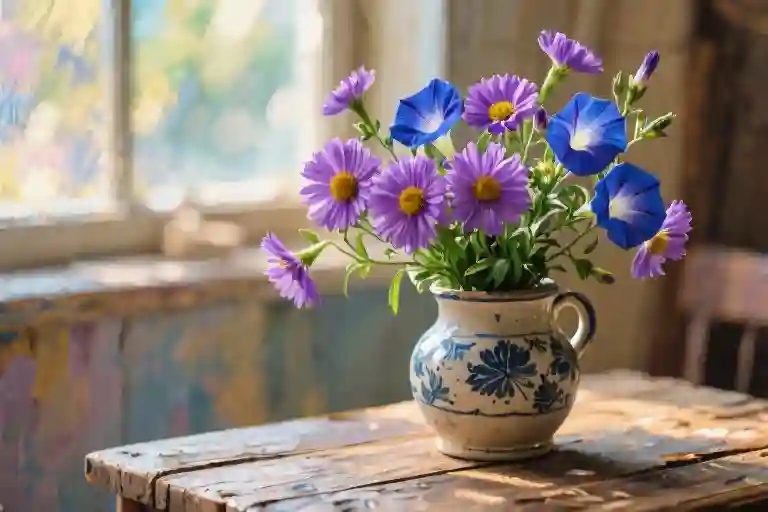The chill of January air carries a particular kind of magic – the quiet anticipation of new beginnings wrapped in winter’s grasp. For those born in this crystalline month, nature offers two floral emissaries that couldn’t be more different in temperament yet perfectly complementary: the exuberant carnation and the demure snowdrop. These January birth flowers don’t just bloom; they perform a delicate dance between warmth and resilience, each telling its own story through petals and stems.
Carnations arrive like cheerful guests at a winter gathering, their ruffled layers defying the season’s austerity with vibrant crimsons, soft pinks, and creamy whites. There’s something wonderfully democratic about them – equally at home in a child’s buttonhole or an elaborate wedding centerpiece. Their very structure suggests abundance, each tightly packed petal whispering secrets of devotion and lasting affection. The Greeks called them ‘dianthus’, flowers of the gods, though their true power lies in their human-scale comfort.
Meanwhile, snowdrops conduct their quiet revolution at ground level. These nodding white bells emerge when logic says nothing should grow, pushing through frozen earth with determination that borders on defiance. Their appearance – usually when winter seems it will never end – explains why they’ve symbolized hope across countless cultures. Unlike the showy carnation, snowdrops demand you kneel to appreciate their beauty, creating intimate moments of discovery in gardens and woodland edges.
What makes this floral pairing so remarkable is how they embody January’s dual nature. The carnation, with its Mediterranean origins, carries the warmth of remembered sunshine in its scent and texture. The snowdrop, adapted to alpine conditions, represents our capacity to flourish in challenging circumstances. Together, they form a complete emotional language for winter birthdays – the comfort of steadfast love paired with the promise of brighter days.
These flowers also solve a very practical problem. January birthdays often get overshadowed by holiday celebrations, leaving gift-givers scrambling for meaningful options. A bouquet combining these two birth flowers becomes more than decoration; it’s a coded message that says ‘I know who you are’ in the language of petals. The carnation’s durability (it can last up to three weeks in a vase) makes it ideal for post-holiday budgets, while the snowdrop’s fleeting appearance reminds us to cherish transient beauty.
There’s wisdom in this floral pairing that extends beyond birthdays. The carnation teaches us about loyalty’s deep roots, while the snowdrop demonstrates how to maintain grace under pressure. Perhaps that’s why these two flowers have endured as January’s representatives – they don’t just celebrate a birth month, but offer living lessons for navigating the whole year ahead.
The Botanical Code of Winter’s Dual Blooms
Few flowers embody the paradox of January quite like its birth flowers. The carnation and snowdrop don’t just survive winter – they reveal nature’s ingenious adaptations through their very structures. Understanding these mechanisms transforms how we see these seasonal emblems.
Carnations wear their survival strategy in plain sight. Those distinctive ruffled petals aren’t merely decorative; they’re evolutionary armor. The layered folds create micro-air pockets that insulate the reproductive organs from freezing temperatures. Modern cultivars maintain this trait even when grown in greenhouses, carrying the genetic memory of their Mediterranean ancestors’ struggle against cold snaps. Florists often note how carnations outlast roses in winter bouquets – now we know those crumpled petals are nature’s version of thermal underwear.
Snowdrops operate on an entirely different biological timetable. Their emergence isn’t just seasonal but exquisitely synchronized to soil conditions. The bulbs contain specialized proteins that function as molecular thermometers, triggering growth only after sustained cold periods (a process called vernalization). This explains why snowdrops sometimes push through frozen ground weeks before other plants stir – their internal clock calculates not just temperature averages but duration of cold exposure. Gardeners in temperate zones report snowdrops blooming within 48 hours of snowmelt, as if the flowers possess some secret meteorological algorithm.
What makes these adaptations remarkable isn’t just their effectiveness, but their divergence. Carnations developed physical barriers against cold, while snowdrops evolved biochemical precision. One flower armors itself against winter’s assault, the other negotiates with it through perfect timing. This duality mirrors January itself – a month of harshness and hope, where survival strategies vary as widely as the personalities born under its sign.
Next time you encounter these January birth flowers, look beyond their symbolic meanings. Those ruffled carnation petals contain eons of evolutionary problem-solving, while each snowdrop stem hides a biological supercomputer calculating spring’s arrival. They’re not just pretty faces of winter, but botanical marvels that have cracked the code of cold-weather survival.
The Secret Language of January Blooms
Carnations have whispered through history long before they became January’s birth flower. In Shakespeare’s The Winter’s Tale, the playwright tucked these ruffled blossoms into pivotal scenes – not as mere decoration, but as silent narrators. When Perdita distributes flowers in Act IV, the absence of carnations among her ‘flowers of winter’ speaks volumes about their cultural weight in Elizabethan England. These were flowers that carried messages too complex for dialogue.
What makes this particularly fascinating is how carnations transformed from theatrical symbols to universal messengers. The same flower that represented aristocratic intrigue in Renaissance dramas became the working-class hero of floral communication during the Industrial Revolution. Factory workers who couldn’t afford elaborate gifts would pin single carnations to their lapels, using color positioning as secret code. A red bloom tilted toward the heart meant passionate devotion, while a white one angled downward signaled cautious friendship.
Snowdrops tell a darker, more poetic story in Gothic literature. Edgar Allan Poe wasn’t writing about Galanthus nivalis when he described the decay of the House of Usher, but the flower’s appearance in later adaptations wasn’t accidental. These delicate white bells became visual shorthand for resurrection in Victorian horror – their ability to push through frozen ground mirroring the genre’s obsession with life persisting beyond death. Modern florists have inherited this symbolism; it’s why snowdrop motifs frequently appear in memorial arrangements during January.
The duality of these January birth flowers reflects our own winter contradictions. Carnations, with their spicy clove-like fragrance and sturdy stems, embody the warmth we crave in cold months. Snowdrops, nearly scentless but miraculously frost-resistant, represent the quiet resilience we admire but rarely celebrate. Together they form a complete emotional alphabet – one that predates Hallmark cards by centuries.
Next time you encounter a bouquet containing these January birth flowers, look beyond their physical beauty. That carnation’s layered petals might be echoing Ophelia’s coded messages in Hamlet. Those snowdrops bobbing in a vase could be reciting lines from a forgotten Gothic poem. Their meanings have been cultivated through art and literature as deliberately as any gardener tends their plot.
What remains unchanged is their core symbolism: carnations still say ‘I cherish you’ in the language of ruffled petals, while snowdrops continue to whisper ‘hope survives’ through their snow-melting determination. The real magic happens when we use them not just as January birth flowers, but as living punctuation in our own life stories.
Contemporary Floral Formulas: Gift Ideas for Every Budget
The beauty of January birth flowers lies not just in their symbolism, but in their remarkable versatility. Whether you’re crafting a heartfelt gift on a student budget or commissioning an heirloom-quality arrangement, carnations and snowdrops offer surprising flexibility that belies their seasonal specificity.
The Thoughtful Minimalist ($20-40 range)
For those seeking meaningful yet affordable options, consider these approaches:
- Living Miniatures: A terracotta pot planted with snowdrop bulbs (they’ll bloom indoors within weeks) paired with a single stem of spray carnations in a test tube vase creates a dynamic living sculpture. The contrast between the emerging snowdrops and the fully bloomed carnations mirrors January’s transitional nature.
- Pressed Flower Art: Create a framed composition using dried carnation petals forming a heart shape, bordered by delicate snowdrop specimens. Local botanical gardens often offer pressing workshops during winter months.
- Scented Stationery: Carnation-infused writing paper (the flowers retain their clove-like fragrance when dried) bundled with envelopes lined with snowdrop illustrations makes for unexpectedly personal correspondence.
The Considerate Connoisseur ($50-80 range)
Mid-range budgets unlock creative combinations:
- The Winter Terrarium: A glass cloche arrangement featuring white carnations as the ‘snow canopy’ over a bed of preserved moss with porcelain snowdrop figurines peeking through. Adds whimsy to office desks.
- Unexpected Pairings: As suggested in our outline, combining red carnations with drought-resistant succulents like echeveria creates a striking metaphor for love that persists through harsh conditions. Wrap the stems in hessian for rustic appeal.
- Edible Interpretations: Commission local bakers for carnation petal-infused shortbread cookies (perfectly safe when using organic flowers) dusted with snowdrop-shaped icing. Package in a reusable tin decorated with pressed flowers.
The Luxurious Gesture ($90-120 range)
For milestone celebrations, these elevated concepts impress:
- The Frost & Fire Centerpiece: A crystal vase holding two distinct layers – floating snowdrop blooms in chilled water below, with fiery orange carnations suspended above using clear floral wire. Creates a mesmerizing temperature contrast.
- Heirloom Jewelry: Work with artisan jewelers to create a pendant featuring a miniature enamel carnation alongside a snowdrop crafted from ethically sourced diamonds. Some studios even encapsulate actual dried flower fragments in resin.
- Living Wall Art: A vertical frame planted with alternating carnation and snowdrop varieties that bloom sequentially throughout winter. Professional florists can design self-watering systems for low-maintenance gifting.
Unconventional Pairings Worth Exploring
Beyond traditional bouquets, consider:
- Carnations with architectural elements like dried lotus pods or bleached pinecones for masculine appeal
- Snowdrops paired with dark hellebores for gothic romance aesthetics
- Mini carnation buds threaded into tulle ribbon as unconventional gift wrapping accents
Remember, the most memorable floral gifts often break conventions. A single pristine snowdrop presented in a vintage pillbox can carry more emotional weight than an extravagant but impersonal arrangement. January’s birth flowers reward those who embrace their paradoxical nature – delicate yet resilient, festive yet restrained, much like the month they represent.
The Secret Language of January Blooms
Buried in the petal folds of carnations and the delicate droop of snowdrops lie stories even botanists rarely tell. These January birth flowers carry hidden codes that once shaped royal courts and now whisper through space stations.
Victorian Flower Cryptography
In an era when direct emotional expression was taboo, carnations became botanical telegrams. The placement of a single bloom could declare war or propose marriage:
- Left lapel: Secret admiration (a pink carnation tucked here launched a thousand illicit affairs)
- Right ear: Romantic refusal (Queen Victoria reportedly wore white carnations this way to dismiss suitors)
- Handkerchief knot: Coded meeting instructions (three red carnations meant midnight at the greenhouse)
Modern florists still use remnants of this system. A birthday bouquet with carnations facing upward signals celebration, while downward-facing blooms subtly suggest consolation. The original floral emoji, if you will.
Snowdrops in Zero Gravity
When NASA sought plants to test lunar agriculture, snowdrops (Galanthus nivalis) surprised scientists. Their geotropism—the ability to grow against gravity—made them ideal for space experiments.
2005 International Space Station logs show:
- Snowdrop bulbs sprouted 37% faster in microgravity than on Earth
- The characteristic droop disappeared, creating straight stemmed “space snowdrops”
- Astronauts reported the flowers’ honey-like scent became more pronounced
These resilient blooms now feature in astrobotany studies, proving January’s birth flower literally reaches for the stars. The same snowdrops that push through frozen ground on Earth defy cosmic odds in orbit.
Next time you gift these flowers, remember: you’re handling living history. That carnation once carried clandestine messages between lovers, while those snowdrop bulbs contain the genetic blueprint for interplanetary gardens. Not bad for two modest winter blooms.
Closing Thoughts: A Personal Invitation
The tradition of birth flowers carries a quiet magic—it connects us to nature’s rhythms while leaving room for personal interpretation. As we’ve explored the carnation’s vibrant devotion and the snowdrop’s delicate hope, you might find yourself wondering: what other flowers could represent January’s unique spirit?
Perhaps you’d choose the winter jasmine for its cheerful yellow blooms against barren landscapes, or the hellebore with its frost-resistant petals. There are no wrong answers here—only opportunities to create new meanings. That’s the beauty of floral symbolism; it grows and adapts like the plants themselves.
For those inspired to bring these flowers into their lives, here are three organic growers specializing in January’s birth flowers:
- Mountain Valley Carnations (Oregon, USA) – Family-owned since 1948, their heirloom varieties include rare spicy-scented carnations
- Snowdrop Sanctuary (Cotswolds, UK) – Conservation-focused nursery protecting over 300 snowdrop cultivars
- Bloom & Bud Collective (California, USA) – Women-run farm offering dried snowdrop arrangements and carnation cuttings
Before we part ways until February’s floral revelations, consider this: the next time you see a carnation’s ruffled edges or spot snowdrops pushing through frozen ground, pause for a moment. These January birth flowers aren’t just plants—they’re living reminders that even in winter’s depth, loyalty endures and hope persists.




